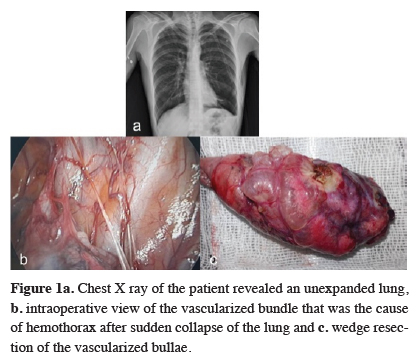

Introduction
Spontaneous hemopneumothorax is a life-threatening complication association with spontaneous pneumothorax and accumulation of more than 400 mL of blood in the pleural cavity [1]. Physiopathology includes ruptured vascularized bullae or lung parenchyma, an aberrant vessel or a hemorrhage from a torn parietal pleura [2].A 25-year-old male was referred to our hospital with unexpanded lung and massive air leaks after chest tube insertion (Figure 1a). The patient was followed for two days at our clinic. Thoracoscopic bullae wedge resection was recommended for him because the air leak was not cease. He underwent thoracoscopic bullae wedge resection for curative intent. We determined a few vascularized bundles that were pending the bullae to apex of the chest intraoperatively (Figures 1b,c). It was seen that the lung did not separate from the thoracic wall and was attached through vascularized fibrous bundles when pneumothorax developed.
 Click Here to Zoom |
Figure 1a: Chest X ray of the patient revealed an unexpanded lung, b. intraoperative view of the vascularized bundle that was the cause of hemothorax after sudden collapse of the lung and c. wedge resection of the vascularized bullae. |
In our case, we detected the potential for spontaneous hemopneumothorax that can occur with the separation of these vascularized fibrous bands in the event of a sudden pulmonary collapse. We think that intraoperative findings of our case are important for explaining the physiopathology of spontaneous hemopneumothorax.
Declaration of conflicting interests
The authors declared no conflicts of interest with respect
to the authorship and/or publication of this article.
Funding
The authors received no financial support for the research
and/or authorship of this article.



